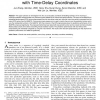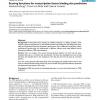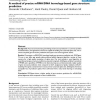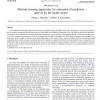127
Voted
TKDE
2008
15 years 21 days ago
2008
Abstract--This paper presents an investigation into the use of the delay coordinate embedding technique in the multi-inputmultioutput-adaptive-network-based fuzzy inference system ...
99
Voted
TKDE
2008
15 years 21 days ago
2008
We present a method for explaining predictions for individual instances. The presented approach is general and can be used with all classification models that output probabilities...
117
click to vote
BMCBI
2005
15 years 21 days ago
2005
Background: The Generalized Hidden Markov Model (GHMM) has proven a useful framework for the task of computational gene prediction in eukaryotic genomes, due to its flexibility an...
111
click to vote
BMCBI
2005
15 years 21 days ago
2005
Background: Transcription factor binding site (TFBS) prediction is a difficult problem, which requires a good scoring function to discriminate between real binding sites and backg...
116
click to vote
BMCBI
2005
15 years 21 days ago
2005
Background: Accurate and automatic gene finding and structural prediction is a common problem in bioinformatics, and applications need to be capable of handling non-canonical spli...
113
click to vote
TFS
2008
15 years 21 days ago
2008
Abstract--In this paper, we introduce a novel approach to timeseries prediction realized both at the linguistic and numerical level. It exploits fuzzy cognitive maps (FCMs) along w...
115
click to vote
TCSV
2008
15 years 21 days ago
2008
Since motion-compensated temporal filtering (MCTF) becomes an important temporal prediction scheme in video coding algorithms, this paper presents an efficient temporal prediction ...
120
click to vote
IJAIT
2007
15 years 21 days ago
2007
Rare events analysis is an area that includes methods for the detection and prediction of events, e.g. a network intrusion or an engine failure, that occur infrequently and have s...
108
Voted
NN
2006
Springer
15 years 22 days ago
2006
Springer
A novel method for estimating prediction uncertainty using machine learning techniques is presented. Uncertainty is expressed in the form of the two quantiles (constituting the pr...
104
click to vote
EXPERT
2007
15 years 22 days ago
2007
Prediction is an important component in a variety of domains. Intelligent systems that can predict future events are better enabled to make more informed, and therefore more relia...






